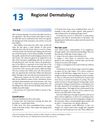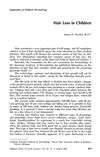TLDR Managing multiple autoimmune diseases in one patient is extremely challenging.
A 33-year-old male with a history of Crohn's colitis diagnosed in childhood experienced sudden hair loss in 2003, leading to a diagnosis of alopecia universalis. At age 28, he was hospitalized with severe dehydration and ketoacidosis, revealing diabetes mellitus type 1. In 2005, he had a severe relapse of Crohn's disease and was treated with systemic corticosteroids. Despite initial improvement, he developed fatigue, hypotension, and bradycardia, leading to a diagnosis of Hashimoto thyroiditis and adrenal cortex failure. Managing his diabetes, hypothyroidism, adrenal insufficiency, and Crohn's disease proved extremely challenging despite intensive treatment.
286 citations
,
August 2007 in “Journal of Clinical Investigation” Alopecia areata is an autoimmune disease where T cells attack hair follicles.
148 citations
,
September 2003 in “Journal of Investigative Dermatology Symposium Proceedings” Alopecia areata is an autoimmune disorder causing hair loss, linked to specific hair follicle antigens and genetic factors.
 January 2017 in “Springer eBooks”
January 2017 in “Springer eBooks” The document explains various skin conditions and their treatments.
 1 citations
,
November 2014
1 citations
,
November 2014 The document explains hair and nail biology, common hair loss conditions and treatments, oral and genital skin diseases, and the risks and treatments associated with squamous cell carcinoma.
 30 citations
,
August 1983 in “Pediatric Clinics of North America”
30 citations
,
August 1983 in “Pediatric Clinics of North America” Most hair loss in children is caused by a few common conditions, and it's important to diagnose these properly and support the child's mental health.
 January 2009 in “Springer eBooks”
January 2009 in “Springer eBooks” The document concludes that managing skin conditions during pregnancy is important and requires specialized care.
 12 citations
,
February 2023 in “Journal of Personalized Medicine”
12 citations
,
February 2023 in “Journal of Personalized Medicine” Type 1 diabetes often occurs with other autoimmune diseases, and personalized treatment based on genetics can improve outcomes.





